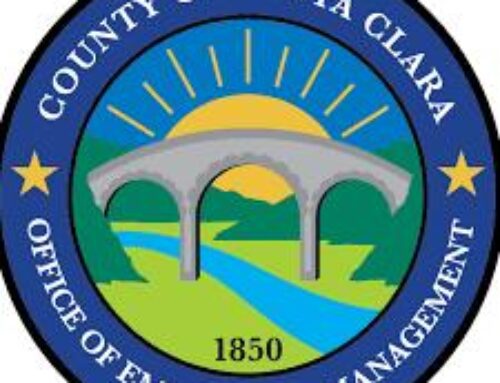Report shows mixed bag of results; council OKs continuing pilot project
Published in the May 27-June 9, 2015 issue of Morgan Hill Life
By Marty Cheek

Photo by Marty Cheek
Pedestrians cross the intersection at Second Street in downtown Morgan Hill recently.
The Morgan Hill City Council unanimously approved continuing with the six-month “complete streets” pilot program after staff at the May 20 meeting presented data collected from the first half of the project by consultant Alta Planning and Design.
The controversial project of reducing Monterey Road from four lanes to two in the downtown corridor and adding buffered bicycle lanes has been a subject of much community discussion. The purpose of the project is to see if changing the street profile will improve the safety, mobility, vibrancy and economic vitality of the downtown business district. The pilot project began Feb. 18 and is scheduled to end July 18. The pilot program will evaluate 16 performance measures, and after the pilot program, the City Council will decide whether to initiate a complete streets program for downtown.
“We’re collecting some good information. This is just at the midpoint and so I think there’s still people adjusting their behavior,” said Maureen Tobin, communications and engagement manager for the city. “There are no decisions made. If we do the full six months, then we’ll have an appropriate amount of data that the council is able to make a well-informed long-term decision.”
Among the data collected during the three-month period, motor vehicle speed on average went from 22.8 miles per hour during the pre-pilot period to 23.6 miles per hour, a 4 percent increase.
The number of collisions decreased from the pre-pilot data collection period to the mid-pilot data collection period, the report found. There were two collisions in the pre-pilot period and one collision during the first three months of the pilot, but this small sample size and short time period makes it difficult to draw any conclusions from this data.
From the data collected, the report found that the typical time it takes to drive through downtown has decreased but the variability in travel times has increased. Before the pilot, drivers would have to build an additional 20 seconds into their trip to account for traffic downtown and now they have to build in an additional 52 seconds.
The average time it takes to go through downtown was 52 seconds in the pre-pilot period and 49 seconds during the pilot period, a decrease of 6 percent.
The data shows that the negative impact in travel time is not as significant as some residents thought it might be and depends on the day of the week and the time of day, Tobin said.
“It is in terms of seconds, it’s minimal. We certainly have witnessed on Friday evenings that it’s a little bit different when people are trying to get through,” she said. “But Friday evenings are kind of an issue in general. A lot of that has to do on what’s on Highway 101 and why people are getting off and cutting through town…. The data here says what it says. It shows very minimal changes.”
One notable finding from the report is that between the pre-pilot and mid-pilot data collection periods, the average number of bicyclists along Monterey Road increased from 43 to 93, a 116 percent increase.
“That’s probably the most significant change that has been recorded,” Tobin said. “One thing you can point to is that there’s a bike lane through downtown now. There didn’t use to be one. I’m sure that encourages bicyclists to actually ride down Monterey through downtown.”
The average pedestrian delay at intersections without signals increased slightly from 1.5 seconds to 1.7 seconds between the pre-pilot to mid-pilot data collection periods.
In regards to downtown parking occupancy, between the pre-pilot and mid-pilot data collection periods, the number of occupied parking spaces increased slightly from 42.6 percent to 44.8 percent, and the parking turnover rate increased slightly from 0.6 to 0.7, the report found.
Downtown residents appeared to grow in disapproval of the pilot program, according to a survey the report took. The percent of residents that indicated that they are in favor of continuing with the pilot program decreased from 50 percent to 38 percent between the pre-pilot and mid-pilot data collection periods.
Economic viability data from the downtown businesses shows a mix during the pilot program.
The city received correspondence from some businesses along or near downtown that their revenues increased from the same time last year and from some businesses that their revenues have decreased from the same time last year. However, formal data is still pending submittal of data and review. A business survey showed that the number of business owners in favor of continuing the pilot increased by 6.2 percent from the pre-pilot to the mid-pilot data periods.






